Pakistan Air Force
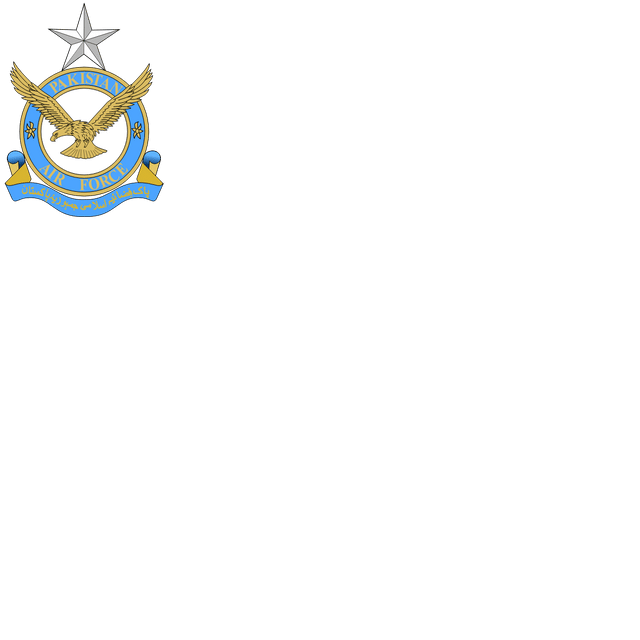
Pakistan Air Force

| Pakistan Air Force | |
|---|---|
| پاک فِضائیہ | |
| Founded | 14 August 1947 (1947-08-14) |
| Country | |
| Allegiance | Pakistan |
| Type | Air Force |
| Role | Aerial and electronic warfare:17[1] |
| Size | 70,000 active duty personnel:70[2] 8,000 Reserve personnel.:70[2] 128 civilian personnel[3] Approx. ~1,011+ aircraft |
| Part of | Ministry of Defence (Pakistan)
|
| Headquarters | Air AHQ in Islamabad Pakistan |
| Nickname(s) | PAF |
| Motto(s) | Urdu: قوم کے لیے فخر کی علامت English: A symbol of pride for the nation |
| Colors | Sky and Air Force Blue |
| Anniversaries | Air Force Day: 7 September |
| Engagements | Major conflicts and wartime operations
|
| Website | paf.gov.pk [192] |
| Commanders | |
| Chief of Air Staff | Air Chief Marshal Mujahid Khan |
| Vice Chief of Air Staff | Air Marshal Asim Zaheer |
| Insignia | |
| Roundel |  |
| Fin flash | |
| Flag |  |
| Aircraft flown | |
| Attack | Mirage 5,[4] NESCOM Burraq, CH-4 |
| Electronic warfare | Falcon DA-20, Saab 2000 Erieye, ZDK-03 (AEW) |
| Fighter | F-16A/B/C/D, JF-17A/B, F-7P/PG |
| Helicopter | Alouette III, Mi-171 |
| Reconnaissance | Mirage IIIRP, Falco UAV, Jasoos II Bravo+ |
| Trainer | FT-5, K-8P, MFI-17, MFI-395, C-12, T-37 |
| Transport | Boeing 707, Airbus A310, C-130B/E/L, CN-235, Saab 2000, Harbin Y-12 |
| Tanker | Ilyushin Il-78 |
The Pakistan Air Force (PAF) (Urdu: پاک فِضائیہ—Pāk Fizāʾiyah, Urdu: [pɑːk fɪzɑːɪjəɦ] or alternatively Urdu: پاکستان ہوائی فوج, Reporting name: PAF) is the aerial warfare uniform service branch of the Pakistan Armed Forces, tasked primarily with the aerial defence of Pakistan, with a secondary role of providing air support to the Pakistan Army and the Pakistan Navy. The PAF has a tertiary role of providing strategic air transport and logistics capability to Pakistan. As of 2017, per IISS, the PAF has 70,000 personnel.[5] It operates 755 aircraft.[6]
Its primary mandate and mission is "to provide, in synergy with other inter-services, the most efficient, assured and cost effective aerial Defence of Pakistan." Since its establishment in 1947, the PAF has been involved in various combat operations, providing aerial support to Inter–Services's operations and relief efforts.[7] Under the Article 243, the Constitution of Pakistan appoints the President of Pakistan as the civilian Commander-in-Chief. The Chief of Air Staff (CAS), by statute a four-star air officer Air Chief Marshal, is appointed by the President with the consultation and confirmation needed from the Prime Minister of Pakistan.[8] The Pakistan Air Force is currently commanded by Air Chief Marshal Mujahid Anwar Khan.[9]
| Pakistan Air Force | |
|---|---|
| پاک فِضائیہ | |
| Founded | 14 August 1947 (1947-08-14) |
| Country | |
| Allegiance | Pakistan |
| Type | Air Force |
| Role | Aerial and electronic warfare:17[1] |
| Size | 70,000 active duty personnel:70[2] 8,000 Reserve personnel.:70[2] 128 civilian personnel[3] Approx. ~1,011+ aircraft |
| Part of | Ministry of Defence (Pakistan)
|
| Headquarters | Air AHQ in Islamabad Pakistan |
| Nickname(s) | PAF |
| Motto(s) | Urdu: قوم کے لیے فخر کی علامت English: A symbol of pride for the nation |
| Colors | Sky and Air Force Blue |
| Anniversaries | Air Force Day: 7 September |
| Engagements | Major conflicts and wartime operations
|
| Website | paf.gov.pk [192] |
| Commanders | |
| Chief of Air Staff | Air Chief Marshal Mujahid Khan |
| Vice Chief of Air Staff | Air Marshal Asim Zaheer |
| Insignia | |
| Roundel |  |
| Fin flash | |
| Flag |  |
| Aircraft flown | |
| Attack | Mirage 5,[4] NESCOM Burraq, CH-4 |
| Electronic warfare | Falcon DA-20, Saab 2000 Erieye, ZDK-03 (AEW) |
| Fighter | F-16A/B/C/D, JF-17A/B, F-7P/PG |
| Helicopter | Alouette III, Mi-171 |
| Reconnaissance | Mirage IIIRP, Falco UAV, Jasoos II Bravo+ |
| Trainer | FT-5, K-8P, MFI-17, MFI-395, C-12, T-37 |
| Transport | Boeing 707, Airbus A310, C-130B/E/L, CN-235, Saab 2000, Harbin Y-12 |
| Tanker | Ilyushin Il-78 |
History
1959 Indian aerial intrusion
On 10 April 1959, on the occasion of the Islamic Eid ul-Fitr festival holiday in Pakistan, an Indian Air Force (IAF) English Electric Canberra B(I)58 of No. 106 Squadron entered Pakistani airspace on a photo reconnaissance mission. Two PAF F-86F Sabres (Flt. Lt. M. N. Butt (leader) and Flt. Lt. M. Yunis) of No. 15 Squadron on Air Defence Alert (ADA) were scrambled from Sargodha Air Base to intercept the IAF aircraft. Butt attempted to bring down the Canberra by firing his Sabre's machine guns, but the Canberra was flying at an altitude of more than 50,000 feet – beyond the operational ceiling of the F-86F. When Yunis took over from his leader, the Canberra suddenly lost height while executing a turn over Rawalpindi. Yunis fired a burst that struck the Canberra at an altitude of 47,500 feet and brought it down over Rawat, near Rawalpindi, marking the first aerial victory of the PAF. Both crew members of the IAF Canberra, ejected and were captured by Pakistani authorities and were subsequently released after remaining in detention for some time.[10]
1965 India–Pakistan War
The PAF fleet at the time consisted of 12 F-104 Starfighters, some 120 F-86 Sabres and around 20 B-57 Canberra bombers.[11] The PAF claims to have had complete air superiority over the battle area from the second day of operations.[12] While, Air Chief Marshal Arjan Singh of the Indian Air Force claimed, despite been qualitative inferior, IAF achieved air superiority in three days in the 1965 War.[13]
Many publications have credited the PAF's successes to U.S. equipment, claiming it to be superior to the aircraft operated by the IAF and giving the PAF a "qualitative advantage". However some Pakistanis refute this argument. As per them, the IAF's MiG-21, Hawker Hunter and Folland Gnat aircraft had better performance than the PAF's F-86 fighters.[14] According to Air Cdre (retired) Sajad Haider, the F-86 Sabre was inferior in both power and speed to the IAF's Hawker Hunter.[14][15][16][17]
According to Air Commodore (retired) Sajjad Haider who flew with No. 19 squadron, the F-104 Starfighter did not deserve its reputation as "the pride of the PAF" because it "was unsuited to the tactical environment of the region. It was a high-level interceptor designed to neutralize Soviet strategic bombers in altitudes above 40,000 feet." Nevertheless, the IAF is believed to have feared the Starfighter[18] although, it was not as effective as the IAF's Folland Gnat.[19] According to Indian sources, the F-86F performed reasonably well against the IAF Hawker Hunters but not as well against the Folland Gnat, which was nicknamed Sabre Slayer by the IAF.[20][21]
According to Indian sources most aircraft losses of IAF were on ground while PAF lost most in aerial combat.[22] Even though the IAF flew a larger offensive air campaign by devoting 40% of its air effort to offensive air support alone, according to Indian sources the majority of its losses came from aircraft destroyed on the ground through PAF air strikes.[22] The PAF had achieved far more in terms of enemy aircraft destroyed on the ground but without doubt, the IAF had achieved much more in the close support role.[22]
The two countries have made contradictory claims of combat losses during the war and few neutral sources have verified the claims of either country. The PAF claimed it shot down 104 IAF planes and lost 19 of its own, while the IAF claimed it shot down 73 PAF planes and lost 59.[23] According to the independent sources, the PAF lost some 20 aircraft while the Indians lost 60–75.[24][25] Despite the intense fighting, the conflict was effectively a stalemate.[26]
1971 India–Pakistan War
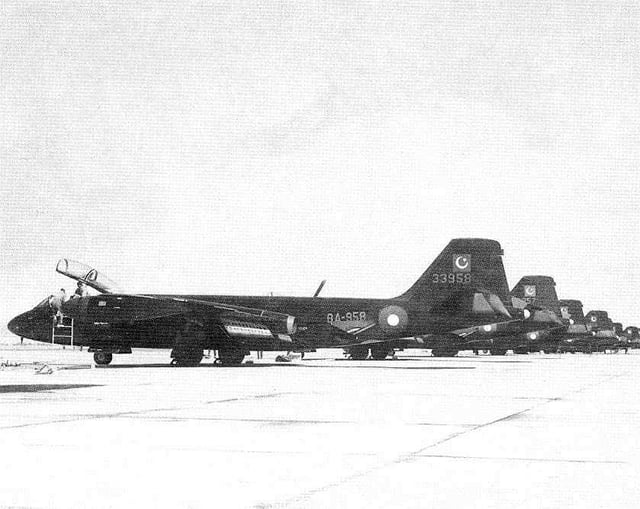
PAF B-57 Canberra bombers lined up at an airbase.
By late 1971, the intensification of the independence movement in erstwhile East Pakistan lead to the Bangladesh Liberation War between India and Pakistan .[27] On 22 November 1971, 10 days before the start of a full-scale war, four PAF F-86 Sabre jets attacked Indian and Mukti Bahini positions at Garibpur, near the international border. Two of the four PAF Sabres were shot down and one damaged by the IAF's Folland Gnats.[28] On 3 December, India formally declared war against Pakistan following massive preemptive strikes by the PAF against Indian Air Force installations in Srinagar, Ambala, Sirsa, Halwara and Jodhpur. However, the IAF did not suffer significantly because the leadership had anticipated such a move and precautions were taken.[29] The Indian Air Force was quick to respond to Pakistani air strikes, following which the PAF carried out mostly defensive sorties.[30]
Hostilities officially ended at 14:30 GMT on 17 December, after the fall of Dacca on 15 December. The PAF flew about 2,840 sorties and destroyed 45 IAF aircraft while Pakistan lost 75 aircraft.[31]
1979–1988 Soviet–Afghan War
In 1979, the PAF's Chief of Air Staff, Air Chief Marshal Anwar Shamim, was told by then President, and Chief of Army Staff General Zia-ul-Haq, that Pakistan had reliable intels on Indian plans to attack and destroy the Pakistan's nuclear research facilities at Kahuta. ACM Shamim told General Zia that, "Indian aircraft could reach the area in 3 minutes whereas the PAF would take 8 minutes, allowing the Indians to attack the facility and return before the PAF could defend it". Because Kahuta was close to the Indian border it was decided that the best way to deter an Indian attack would be to procure new advanced fighters and weaponry. These could be used to mount a retaliatory attack on India's nuclear research facilities at Trombay in the event of an Indian attack on Kahuta. It was decided the most suitable aircraft would be the F-16 Fighting Falcon, which the United States eventually agreed to supply after the PAF refused to purchase the F-5E and F-5G. In 1983, when the first batch of F-16s reached Pakistan, ACM Shamim informed Zia of the PAF's capability to respond to an attack on the nuclear research facilities at Kahuta.[32][33]
Rising tensions with neighboring USSR in their involvement in Afghanistan, Pakistani intelligence community, mostly the ISI, systematically coordinated the U.S. resources to the Afghan mujahideen and foreign fighters against the Soviet Union's presence in the region. Military reports indicated that the PAF was in engagement with the Soviet Air Force, supported by the Afghan Air Force during the course of the conflict;[34] one of which belonged to Alexander Rutskoy.[34]
A letter of agreement for up to 28 F-16A and 12 F-16B was signed December 1981. The contracts, Peace Gate I and Peace Gate II, were for 6 and 34 Block 15 models respectively which would be powered by the F100-PW-200 engine. The first Peace Gate I aircraft was accepted at Fort Worth in October 1982. Two F-16A and four F-16B were delivered to Pakistan in 1983, the first F-16 arriving at PAF Base Sargodha (now known as PAF Base Mushaf) on 15 January 1983 flown by Squadron Leader Shahid Javed. The 34 remaining Peace Gate II aircraft were delivered between 1983 and 1987.[35][36]
Between May 1986 and November 1988,[37] PAF F-16s have shot down at least eight intruders from Afghanistan. The first three of these (one Su-22, one probable Su-22, and one An-26) were shot down by two pilots from No. 9 Squadron. Pilots of No. 14 Squadron destroyed the remaining five intruders (two Su-22s, two MiG-23s, and one Su-25).[38] Most of these kills were by the AIM-9 Sidewinder, but at least one (a Su-22) was destroyed by cannon fire. Flight Lieutenant Khalid Mahmoud is credited with three of these kills. One F-16 was lost in these battles during an encounter between two F-16s and four Soviet Air Force MiG 23s on 29 April 1987. This loss turned out to be an unexpected case of fratricide, with the formation leader, Wing Commander Amjad Javed mistakenly shooting down his wingman, Flight Lieutenant Shahid Sikandar Khan, who ejected safely.[39][40][41]
The PAF is believed to have evaluated the Dassault Mirage 2000 in early 1981 and was planning to evaluate the F-16 Fighting Falcon afterwards.[42]
1990–2001
After the Pressler amendment was passed, the U.S. placed sanctions and an arms embargo on Pakistan on 6 October 1990 due to the country's continued nuclear weapons programme. All eleven Peace Gate III F-16s, along with 7 F-16A and 10 F-16B of the 60 Peace Gate IV F-16s, which had been built by the end of 1994 were embargoed and put into storage in the United States.[35][36]
Desperate for a new high-tech combat aircraft, between late 1990 and 1993 the PAF evaluated the European Panavia Tornado MRCA (multi-role combat aircraft) and rejected it. The Mirage 2000E and an offer from Poland for the supply of MiG-29 and Su-27 were also considered but nothing materialised. In 1992 the PAF again looked at the Mirage 2000, reviving a proposal from the early 1980s to procure around 20–40 aircraft, but again a sale did not occur because France did not want to sell a fully capable version due to political reasons. In August 1994 the PAF was offered the Saab JAS-39 Gripen by Sweden, but again the sale did not occur because 20% of the Gripen's components were from the U.S. and Pakistan was still under U.S. sanctions.[43]
In mid-1992 Pakistan was close to signing a contract for the supply of 40 Dassault Mirage 2000, equipped with Thomson-CSF RDM/7 radars, from France.[44]
In mid-1994 it was reported that the Russian manufacturers Sukhoi and Mikoyan were offering the Su-27 and MiG-29.[45] But Pakistan was later reported to be negotiating for supply of the Dassault Mirage 2000-5.[46] French and Russian teams visited Pakistan on 27 November 1994 and it was speculated that interest in the Russian aircraft was to pressure France into reducing the price of the Mirage 2000. Stated requirement was for up to 40 aircraft.[47]
War in Afganistan 2001– present
2008 air alert
After the 2008 Mumbai attacks, Pakistan Air Force was put on high alert. It deployed to all its wartime locations and started combat air patrols. The speed and intensity of the deployment and PAF's readiness took the Indian Army High Command by surprise and later reports suggest was the main factor in the Indian decision of not going for cross border raids inside Pakistan.[50][51] PAF was issued a Standing Order to launch an immediate counter-attack in case of an air attack from India, after a call from the Indian Foreign Minister Pranab Mukherjee to the Pakistani President Asif Ali Zardari (the call later turned out to be a hoax).[50][51][52][53][54]
2011 Abbottabad Operation
An initial investigation report revealed that the Pakistan Air Force (PAF) reported the movement of some half-a-dozen planes near the Jalalabad border at 11 pm before the US helicopters entered Abbottabad to kill Osama bin Laden. "One aircraft was identified as a US AWACS and the remaining five were recognised as F-18 jets of the US. These planes flew near the Pakistani border, but did not cross into the airspace of Pakistan,"[55]
On detection of intrusion, PAF jets on air defence alert were scrambled and the PAF immediately took adequate operational measures as per standard operating procedure. The PAF aircraft continued their presence in Abbottabad area until early morning and later returned to their air bases.[56]
However, the fact that so many non-stealth aircraft had entered Pakistani airspace, stayed for 3 hours to carry out a major operation, and that PAF jets only arrived at the location 24 minutes after the American helicopters had left made a senior PAF official term it "one of the most embarrassing" incidents in Pakistan's history.[57]
2001–present Counter-insurgency operations in northwest Pakistan

Pakistani air force Mirage III aircraft drops two 500-pound bombs during Falcon Air Meet 2010 at Azraq Royal Jordanian Air Base in Azraq, Jordan
The Pakistan Army faced several problems during its 2009 offensive against the Taliban in north-west Pakistan. Hundreds of thousands of Pakistanis vacated the area when the offensive was announced and, eventually, over 2 million had to be accommodated in refugee camps. The offensive was to be completed as quickly as possible to allow the refugees to return to their homes but the army's fleet attack helicopters were not sufficient to provide adequate support to the infantry. The PAF was sent into action against the Taliban to make up for the lack of helicopter gunships. Because the PAF was trained and equipped to fight a conventional war, a new "counter-terrorist doctrine" had to be improvised.[58]
The PAF's Saffron Bandit 2009/2010 exercise focused on extensive training of combat personnel to undertake COIN operations. New equipment was inducted to improve the PAF's joint intelligence, surveillance and reconnaissance (ISR) capabilities. A C-130 transport aircraft was indigenously modified for day/night ISR operations.[58][59]
Use of laser-guided bombs was increased to 80% of munitions used, as compared to 40% in the previous 2008 Bajaur campaign. A small corps of ground spotters were trained and used by the PAF, in addition to PA spotters, to identify high-value targets.[60]
Prior to the PA's offensive into South Waziristan the PAF attacked militant infrastructure with 500 lb and 2000 lb bombs.[60]
A number of civilian deaths occurred during PAF air strikes on 10 April 2010 in the Khyber tribal region. According to a Pakistani military source, the first bombing was targeted at a gathering of militants in a compound. Local people, who had quickly moved onto the scene to recover the dead and wounded, were then killed during a second air strike. There was no confirmed death toll but at least 30 civilian deaths had occurred according to the military source, whereas a local official stated at least 73 locals, including women and children, were killed.[61] A six-member committee of tribal elders from the area, tasked with finding the exact number of civilian casualties, reported that 61 civilians were killed and 21 wounded. This was not confirmed by military or political leaders but Pakistan's Chief of Army Staff, General Ashfaq Kayani, gave a public apology on 17 April.[62][63] It is reported that BBC news and several other media correspondences were not allowed to take interviews from injured which makes the whole episode more mysterious.[64]
2019 India–Pakistan standoff
On 26 February 2019, unspecified Pakistani Air Force jets were reported to have launched an attack against Indian Air Force aircraft striking targets in the contested region of Jammu Kashmir. In some reports the Indians broke off their attack early with limited losses. In other reports the Indians were able to complete the attack, without the two air forces' aircraft encountering each other.[65] On 27 Feb 2019, during the standoff between India and Pakistan, Pakistan launched a counter offensive by striking six Indian targets near Indian military installations. Indian Air Force jets were scrambled to intercept during which Pakistan claimed that its JF-17s had shot down two Indian MiG-21s operating in airspace over the disputed region of Jammu Kashmir.[66][67] India claimed to have lost only one MiG-21 while shooting down a Pakistani F-16.[68] The Pakistani Government's public relations spokesman rejected India's statement, stating that Pakistan used no F-16s in the whole exercise.[69] On 6 April, it was revealed by the US defense officials performed a count on the insistence of Pakistan had revealed that all Pakistan Air Force's F-16s were accounted for and none of them were missing debunking India's claim. Meanwhile, a Twitter post reportedly shows PAF Squadron Leader, Hasan Siddiqui, taking credit for the downing of an Indian MiG-29.[70] The aircraft behind him resembles a JF-17, owing to its air intakes.[71]
Structure
Commands
Air Force Strategic Command (AFSC), Islamabad
Northern Air Command (NAC), Peshawar
Central Air Command (CAC), Lahore
Southern Air Command (SAC), Karachi
Air Defence Command (ADC), Rawalpindi
Bases
The PAF has 21 air bases, comprising 13 flying bases and 8 non-flying bases. Flying bases are operational bases from which aircraft operate during peacetime and wartime; whereas non-flying bases conduct either training, administration, maintenance, Air Defense operations or mission support.[72]
Rank structure
- Structure of the Commissioned officer rank of the Pakistan Air Force
- Structure of the Enlisted rank of the Pakistan Air Force
- Civilians
Civilian Gazetted Officer
Stenographer
Stenotypist
Storeman
Clerk
Personnel
List of Air Chiefs
Air Vice Marshal Allan Perry-Keene (15 August 1947 – 17 February 1949)
Air Vice Marshal Richard Atcherley (18 February 1949 – 6 May 1951)
Air Vice Marshal Leslie William Cannon (7 May 1951 – 19 June 1955)
Air Vice Marshal Arthur McDonald (20 June 1955 – 22 July 1957)
Air Marshal Asghar Khan (23 July 1957 – 22 July 1965)
Air Marshal Nur Khan (23 July 1965 – 31 August 1969)
Air Marshal Abdul Rahim Khan (1 September 1969 – 2 March 1972)
Air Marshal Zafar Chaudhry (3 March 1972 – 15 April 1974)
Air Chief Marshal Zulfiqar Ali Khan (16 April 1974 – 22 July 1978)
Air Chief Marshal Anwar Shamim (23 July 1978 – 5 March 1985)
Air Chief Marshal Jamal A. Khan (6 March 1985 – 8 March 1988)
Air Chief Marshal Hakimullah (9 March 1988 – 9 March 1991)
Air Chief Marshal Farooq Feroze Khan (9 March 1991 – 8 November 1994)
Air Chief Marshal Abbas Khattak (8 November 1994 – 7 November 1997)
Air Chief Marshal Parvaiz Mehdi Qureshi (7 November 1997 – 20 November 2000)
Air Chief Marshal Mushaf Ali Mir (20 November 2000 – 20 February 2003)
Air Chief Marshal Kaleem Saadat (18 March 2003 – 18 March 2006)
Air Chief Marshal Tanvir Mahmood Ahmed (18 March 2006 – 18 March 2009)
Air Chief Marshal Rao Qamar Suleman (19 March 2009 – 19 March 2012)
Air Chief Marshal Tahir Rafique Butt (19 March 2012 – 19 March 2015)
Air Chief Marshal Sohail Aman (19 March 2015 – 19 March 2018)[73]
Air Chief Marshal Mujahid Anwar Khan (19 March 2018 - present)
Serving Air Marshals
Awards for valour
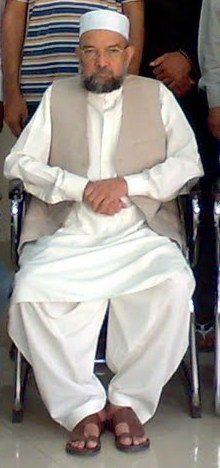
Air Commodore MM Alam "Little Dragon". Ace in a Day of the Pakistan Air Force
The Nishan-e-Haider (Urdu:نشان حیدر) (Order of Ali), is the highest military award given by Pakistan. Pilot Officer Rashid Minhas (1951 – 20 August 1971) is the only officer of the PAF to be awarded the Nishan-e-Haider for sacrificing his life to save an aircraft from being hijacked to India.[74] Other awards include:
Squadron Leader Muhammad Mahmood Alam – awarded for downing nine fighters,[75] five in a minute,[76][77][78][79][80] of the Indian Air Force in air-to-air combat.[81]
Squadron Leader Sarfaraz Ahmed Rafiqui Shaheed – awarded for refusing to abandon his group of fighters during a battle despite his guns being jammed. He continued his attempts to assist his squadron in the battle by chasing enemy fighters until eventually being shot down.[82]
Special Forces
Women in the PAF
Previously, women had been employed by Pakistan's armed forces in non-combat roles only, such as the medical corps,[83] and the PAF had remained all-male throughout its history.[84] However, since 2003 women have been allowed to enroll in the aerospace engineering and other programs of PAF Academy Risalpur, including fighter pilot training programmes.[83] It has been stated that standards are not compromised for women, those who do not achieve the same performance as their male counterparts are dropped from the course. A level of segregation between the genders is maintained. For example, early-morning parades are performed together but some parts of training, mainly physical exercises, are done with males and females separated. According to Squadron Leader Shazia Ahmed, the officer in charge of the first female cadets and a psychologist, this also improves confidence of the women.[84]
In 2005 it was reported that two batches in the Air Force Academy's flying wing contained 10 women, with many more in the engineering and aerospace wings. Cadet Saba Khan, from Quetta in Balochistan, applied after reading a newspaper advertisement seeking female cadets. She was one of the first four women to pass the first stages of flying training on propeller-driven light aircraft and move onto faster jet-powered training aircraft.[84]
In March 2006, the PAF inducted a batch of 34 fighter pilots which included the organisation's first four female fighter pilots. Three years of training had been completed by the pilots at PAF Academy Risalpur before they graduated and were awarded their Flying Badges during the ceremony. Certificates of honour were handed to the successful cadets by a "delighted" General Ahsan Saleem Hayat, vice chief of the Pakistan Army, who acknowledged that the PAF was the first of the Pakistan Armed Forces to introduce women to its combat units. One of the women, Flying Officer Nadia Gul, was awarded a trophy for best academic achievement. The other female graduates were Mariam Khalil, Saira Batool and the above-mentioned Saba Khan.[83] A second batch of pilots, including 3 female pilots, graduated from the 117th GD(P) course at PAF Academy Risalpur in September 2006. The Sword of Honour for best all-round performance was awarded to Aviation Cadet Saira Amin, the first female pilot to win the award. Aviation Cadet Saira Amin won the Asghar Hussain Trophy for best performance in academics.[85]
In September 2009 it was reported that seven women had qualified as operational fighter pilots on the Chengdu F-7, the first female combat pilots in the PAF's history, one of them being Ambreen Gull. Commanding Officer Tanvir Piracha emphasised that if the female pilots "are not good enough as per their male counterparts, we don't let them fly." It was noted that some of the female pilots wear the hijab while others do not.[86]
Religious minorities in the PAF
Religious minorities have served in the PAF with distinction since its inception: Air Vice Marshal Eric Gordon Hall was Base Commander of Chaklala Air Base during the 1965 Indo-Pak War; Air Commodore Nazir Latif; Group Captain Cecil Chaudhry fought in the 1965 Indo-Pak War and, later helped establish the Combat Commanders School (CCS); Wing Commander Melvin Leslie Middlecoat was Commanding Officer of No. 9 Squadron during the 1965 Indo-Pak War; Squadron Leader Peter Christy; Patrick Desmond Callaghan is another Christian officer who rose to the rank of Air Vice Marshal.[87] Wing Commander Ronald Felix is a test pilot on the JF-17 Thunder since 2010 and was one of two PAF pilots flying the JF-17 at the 2011 Izmir Air Show in Turkey.
Aircraft
Current inventory
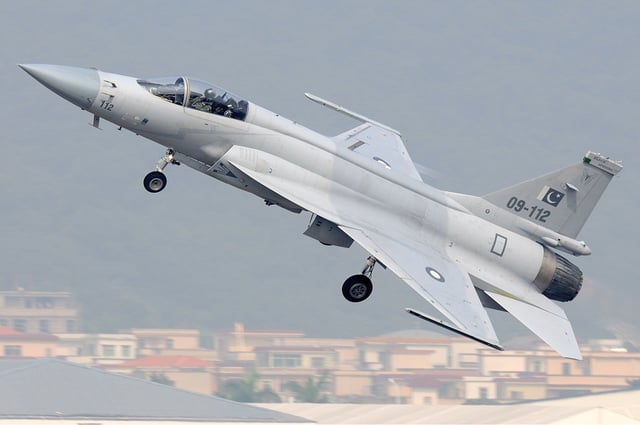
A Chengdu JF-17 taking off from Zhuhai Jinwan Airport
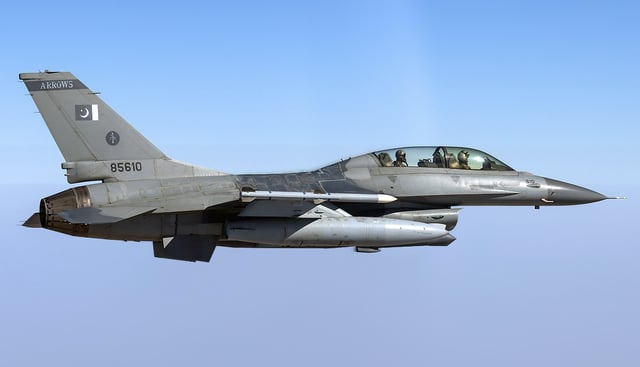
A Pakistani F-16BM in flight
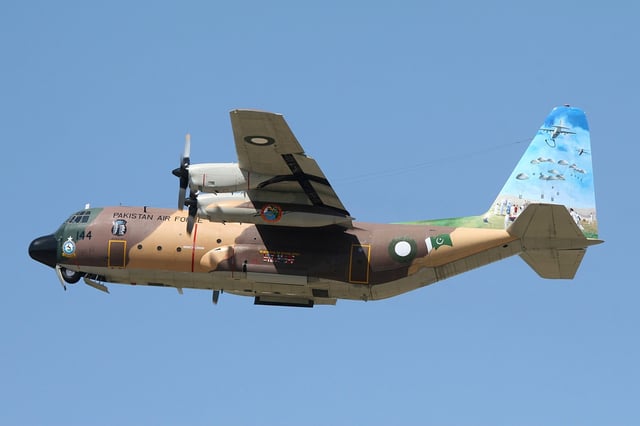
A Lockheed L-100 Hercules departing RIAT 2006
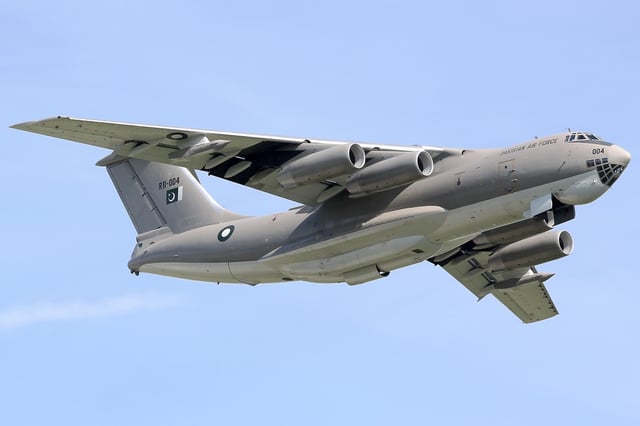
A Ilyushin Il-78 over Pisa International
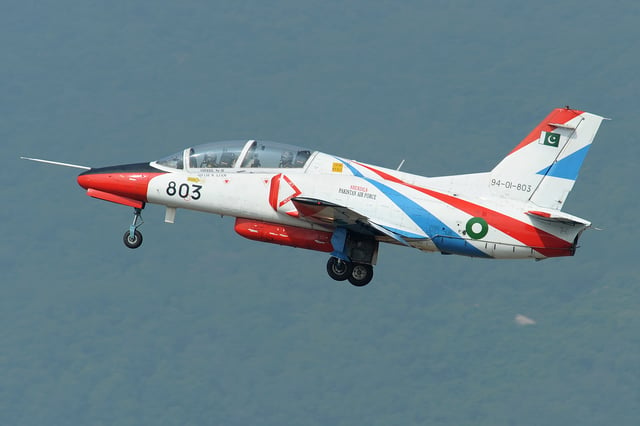
A Pakistani Hongdu JL-8 trainer
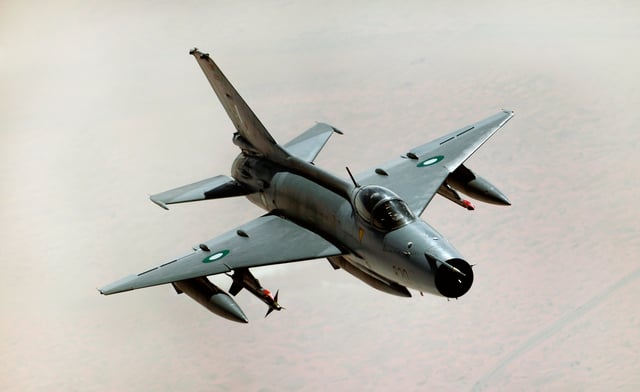
Chengdu F-7PG
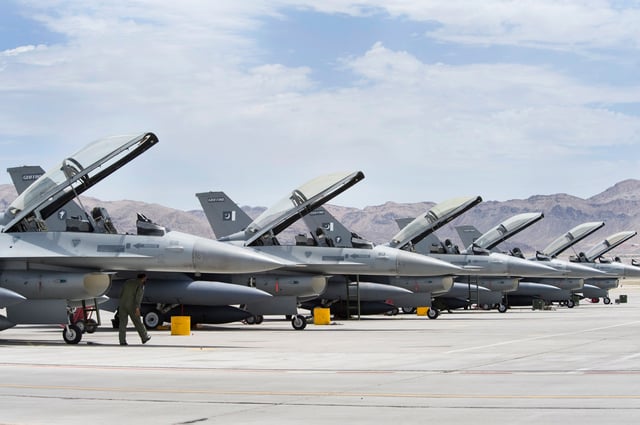
PAF F-16s in 2010
| Aircraft | Origin | Type | Variant | In service | Notes | |
|---|---|---|---|---|---|---|
| Combat Aircraft | ||||||
| Mirage 5 | France | attack | 5EF/F/PA | 90[88] | ||
| Mirage III | France | interceptor | IIIEP/OF/RP | 69[88] | ||
| Chengdu J-7 | China | fighter | F-7PG | 136[88] | ||
| JF-17 Thunder | China / Pakistan | multirole | 98 | 12 on order[88] | ||
| F-16 Fighting Falcon | United States | multirole | F-16A/C | 45[88] | ||
| AWACS | ||||||
| Saab 2000 | Sweden | AEW&C | 4[88] | equipped with the Erieye radar | ||
| Shaanxi Y-8 | China | AEW&C | ZDK-03 | 4[88] | ||
| Electronic Warfare | ||||||
| Falcon 20 | France | EW / radar jamming | 2[88] | |||
| Reconnaissance | ||||||
| Super King Air | United States | surveillance | 350 | 2[88] | ||
| Tanker | ||||||
| Ilyushin Il-78 | Russia | aerial refueling | Il-78MP | 3[88] | ||
| Transport | ||||||
| Saab 2000 | Sweden | transport | 6[88] | |||
| Shaanxi Y-8 | China | transport | 3[88] | |||
| CASA CN-235 | Spain / Indonesia | transport | 3[88] | |||
| C-130 Hercules | United States | transport | C-130B/E//L-100 | 16[88] | ||
| Helicopters | ||||||
| Bell 412 | United States | utility | 1[88] | |||
| Bell UH-1 | United States | utility | 5[88] | |||
| Mil Mi-17 | Russia | utility | Mi-17/171 | 6[88] | ||
| AH-1 Cobra | United States | attack | AH-1F | 1[88] | ||
| Aérospatiale SA330 | France | utility / transport | 1[88] | |||
| Aérospatiale Alouette III | France | liaison / utility | 10[88] | |||
| Trainer Aircraft | ||||||
| Super Mushshak | Pakistan | primary trainer | 120[88] | |||
| Mirage 5 | France | conversion trainer | 5DPA2 | 5[88] | ||
| Mirage III | France | conversion trainer | IIIBE/D/DP | 18[88] | ||
| Cessna T-37 | United States | jet trainer | 30 | 22 on order[88] | ||
| Hongdu JL-8 | China | jet trainer | K-8 | 38[88] | ||
| Chengdu J-7 | China | conversion trainer | FT-7 | 7[88] | ||
| Shenyang J-6 | China | jet trainer | F-6 | 9[88] | licensed built MiG-19 | |
| F-16 Fighting Falcon | United States | conversion trainer | F-16B/D | 31[88] | ||
| Aérospatiale Alouette III | France | rotorcraft trainer | 8[88] | |||
| UAV | ||||||
| NESCOM Burraq | Pakistan | reconnaissance | 12[89] | |||
| CASC Rainbow CH-4 | China | reconnaissance | 4[90] | |||
| SATUMA Jasoos II | Pakistan | reconnaissance | Bravo+ | 45[91] | ||
| GIDS Shahpar | Pakistan | surveillance | 5[92] | |||
| SELEX Galileo Falco | Italy | sSurveillance | 25[93] | co-manufacture at the Pakistan Aeronautical Complex | ||
The PAF operates approximately 450 combat aircraft of 4 types, which are planned to be reduced to 2 multirole types, namely the F-16 and JF-17, by 2025. There are around 20 front-line squadrons.[94]
The most capable fighter in PAF service from 1983 to 2007 has been the F-16 Fighting Falcon. 40 of the F-16A/B Block 15 models were delivered from 1983 to 1987. Deliveries of another 28 F-16A/B were stopped after the 1990 arms embargo imposed on Pakistan under the Pressler amendment but 14 of these were later delivered during 2005–2008. The F-16A/B fleet is to be upgraded with MLU (Mid-Life Update) modification kits and Falcon Star Structural Service Life Enhancement kits by Turkish Aerospace Industries starting in September 2010 at a rate of 1 per month. Four F-16A/B are already undergoing upgrade in the U.S. for delivery in 2011. The MLU package will include new APG-69v9 radars, Joint Helmet Mounted Cueing Systems and Link-16 data-links, along with other new communications, targeting and electronic warfare systems.[95][96]
In 2006, 12 F-16C and 6 F-16D Block 52+ were ordered with a further 18 aircraft optional. 14 of the optional fighters were ordered in 2010.[97][98] The first batch of 3 F-16C/D fighters landed at PAF Base Shahbaz, Jacacobad, on 26 June 2010.[99][100] Pakistan also received 14 used F-16s from the US free of cost.[101]
The PAF is to induct a number of the Chinese Chengdu FC-20, an advanced PAF-specific variant of the Chengdu J-10. 36 fighters equipping two FC-20 squadrons are expected to be delivered by 2015[102] and, according to some reports, the FC-20 fleet may eventually be increased to 150 fighters.[103] In September 2015, talks between Russia and Pakistan began on the delivery of the Sukhoi Su-35 air-superiority multi-role fighter.[104]
Special mission aircraft
Airborne early warning and control (AEW&C) aircraft were first sought by the PAF in the 1980s, but the requirement was not met until December 2009 when the first of four Saab 2000 Erieye aircraft ordered in 2006 was delivered. The remaining three Erieye are expected to be delivered in 2010. Built to the PAF's specifications, the Saab 2000 Erieye is fitted with 5 operator stations and 4 command stations. The aircraft's Erieye radar has a range of 450 km and is also capable of identifying the type of aircraft and the weapons it is carrying.[105]
Four Chinese ZDK-03 AEW&C aircraft have also been ordered, with first delivery expected in late 2010.[106] These are believed to be a PAF-specific version of the KJ-200, incorporating a Chinese AESA radar similar to the Erieye mounted on the Shaanxi Y-8F600 transport aircraft.
Transport aircraft
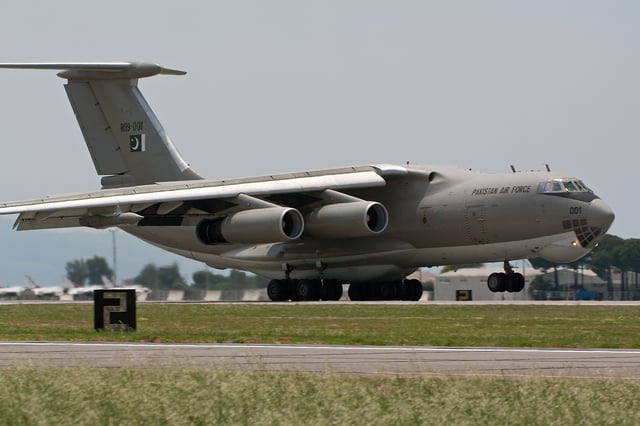
PAF Il-78 aircraft
The C-130 Hercules has been the PAF's primary tactical transport aircraft since its induction in the early 1960s. Currently 5 C-130B and 11 C-130E[107] models are in service, upgraded with Allison T56-A-15 turboprops and extended fatigue lives by Lockheed-Georgia Company.[108] The C-130 is supplemented by 4 CASA/IPTN CN-235 STOL transports, although the fourth aircraft is equipped with an interior for transporting VIPs such as the PAF Chief of Air Staff. Heavy-lift transports comprise 3 Boeing 707s transferred from Pakistan International Airlines starting 1986.
Aerial refuelling aircraft
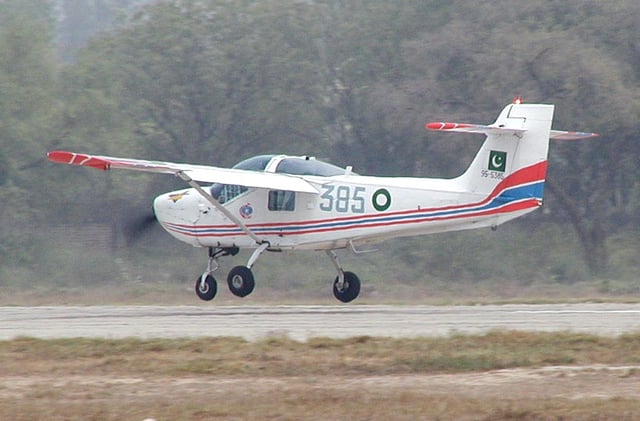
PAF Super Mushak Trainer
In December 2009 the PAF received its first of four Il-78 aircraft which is capable of aerial refuelling as well as transporting cargo. Aerial refuelling capability was first demonstrated during the High Mark 2010 exercise on 6 April 2010 when two of the PAF's Mirage III fighters were simultaneously refuelled in the air by the Il-78.[105][109][110][111][112]
Air defence systems
Crotale is expected to be replaced by Spada 2000.[113]
MBDA Spada 2000 – A low to medium altitude air defence system consisting of a radar with 60 km range and four 6-cell missile launchers. The Aspide 2000 missile can intercept enemy missiles and aircraft at a range of over 20 km. A contract for 10 batteries was signed after Spada 2000 was selected over competing systems from Raytheon, Diehl BGT and Saab AB and pre-contract firing tests in Pakistan, which were assisted by the Italian Air Force.[114] Latest reports state Pakistan is to test the Spada 2000 air defence system in July 2010, followed by deliveries of first of ten batteries. Deliveries of all 10 batteries are reported to be completed by 2013 with further orders possible.[115] Pakistan test fired the new SPADA 2000 Plus air defence missile system in July 2010. The missile system was tested by the Range & Instrumentation Division of SUPARCO (National Space Agency). Three drone planes were successfully intercepted and shot down by the SPADA 2000 Plus Missile System.
HQ-2 – Chinese version of SA-2 Guideline high altitude air defence system, 12 or more batteries procured circa 1970s.
HQ-9 – In October 2003 it was reported that China had closed a deal with Pakistan to supply an unspecified number of FT-2000 systems, an anti-radiation variant of the HQ-9 long range air defence system,[116] although in March 2009 a report was published stating that Pakistan was not considering importing the missile.[117] It was reported in mid-2008 that Pakistan intended to purchase a high altitude air defence and missile defence system and the FD-2000, another variant of HQ-9, was expected to be chosen.[113][118]
AML HE 60-20: Recently sighted at PAF Base Nur Khan. Modified Panhard armoured car with a 20mm anti-aircraft cannon. Used for on-base security.[119] At least 5 were originally in service.[120][121]
Drone technology
On 7 September 2015, Pakistan became the ninth nation to develop and use an armed unmanned combat aerial vehicle (drone) named Burraq. Pakistan first started exploring the drone technology when it acquired Falco drones from Selex Galileo of Italy for $40 million in 2008. Since then Pakistan have been developing Falco in Pakistan Aeronautical Complex in collaboration with the Italian firm. The Burraq was developed which was based on the same Falco technology. By March 2015, Pakistan was able to test-fire Burraq armed with an air-to-surface missile named Barq with pin-point precision. Burraq were used majorly during the Operation Zarb-e-Azb.[122]
Modernisation and acquisitions
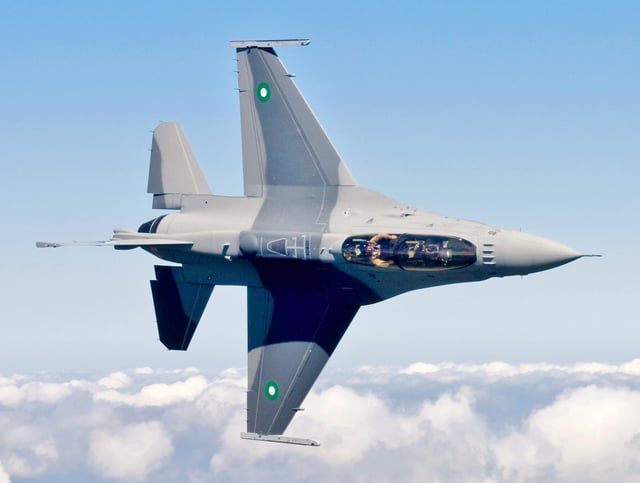
The first F-16D Block 52 fighter of PAF, rolled out on 13 October 2009, undergoing flight testing in the U.S. prior to delivery.
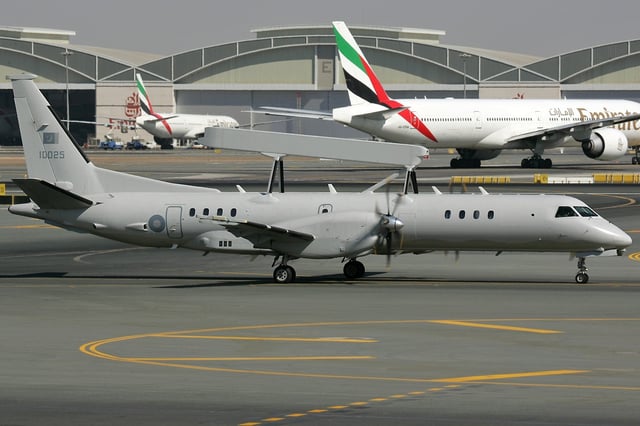
Saab2000 ERIEYE AEW&C
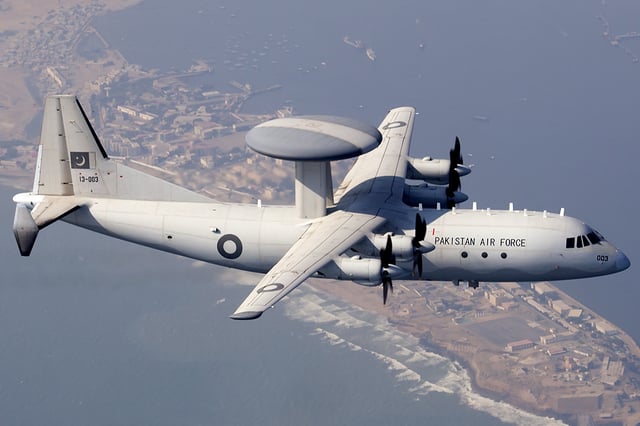
PAF ZDK-03 AEW&C inflight
The modernisation stall ended in April 2006 when the Pakistani cabinet approved the PAF's proposals to procure new aircraft and systems from several sources, including modern combat aircraft from the U.S. and China. The AFFDP 2019 (Armed Forces Development Programme 2019) would oversee the modernisation of the Pakistan Air Force from 2006 to 2019.[123]
The Bush administration on 24 July 2008 informed the US Congress it plans to shift nearly $230 million of $300 million in aid from counterterrorism programs to upgrading Pakistan's ageing F-16s.[124] The Bush administration previously announced on 27 June 2008 it was proposing to sell Pakistan ITT Corporation's electronic warfare gear valued at up to $75 million to enhance Islamabad's existing F-16s.[125] Pakistan has asked about buying as many as 21 AN/ALQ-211(V)9 Advanced Integrated Defensive Electronic Warfare Suite pods, or AIDEWS, and related equipment.[126] The proposed sale will ensure that the existing fleet is "compatible" with new F-16 Block 50/52 fighters being purchased by Islamabad.
After 9/11 the U.S. and Pakistan began discussing the release of the embargoed F-16s and a purchase of new aircraft. Of the 28 F-16A/B built under the Peace Gate III/IV contracts and embargoed in 1990, 14 delivered as EDA (Excess Defense Articles) from 2005 to 2008.,[127] two of which were delivered on 10 July 2007.[128]
Between 2005 and 2008, 14 F-16A/B Block 15 OCU fighters were delivered to the PAF under renewed post-9/11 ties between the U.S. and Pakistan. These had originally been built for Pakistan under the Peace Gate III/IV contracts but were never delivered due to the U.S. arms embargo imposed in 1990.[129]
To upgrade the F-16A/B fleet, 32 Falcon STAR kits were purchased for the original Peace Gate I aircraft and 35 Mid-Life Update (MLU) kits were ordered, with 11 more MLU kits optional, in . 4 F-16A/B being upgraded in the U.S. to F-16AM/BM, delivery expected December 2011.[127] F-16A/B in PAF service to be upgraded starting October 2010 by Turkish Aerospace Industries, 1 per month.[130][131]
The Peace Drive I contract for 12 F-16C and 6 F-16D Block 52+ (Advanced Block 52) aircraft, powered by F100-PW-229 engines was signed on 30 September 2006.[132][133] The first F-16 to be completed, an F-16D, was rolled out on 13 October 2009 and began flight testing.[134][135][136][137][138] The first batch of F-16C/D Block 52+, two F-16D and one F-16C, landed at PAF Base Shahbaz, Jacobabad, on 26 June 2010[99][100] and one more F-16C was received by 5 July 2010.[139]
On 13 December 2008, the Government of Pakistan stated that two Indian Air Force aircraft were intercepted by the PAF kilometres within Pakistani airspace. This charge was denied by the Indian government.[140]
During talks with a delegation from the French Senate on Monday 28 September 2009, Prime Minister Yousuf Raza Gilani stated that the PAF had used most of its stockpile of laser-guided munitions against militants in the Malakand and FATA regions and that replacements for such types of equipment were urgently required.[141]
On 26 June 2010 the first batch of 3 F-16C/D Block 52+ fighters were delivered to PAF Base Shahbaz, Jacobabad.[147] According to Air Chief Marshal Rao Qamar Suleman (the then Chief of Air Staff) the new fighters would eliminate the PAF's limitations in precision night-time strike operations,[148] the existing capability being based on around 34 Dassault Mirage 5 fighters upgraded with new avionics for night-time precision strike missions under the Retrofit of Strike Element (ROSE) programme during 1999–2004.[149][150][151] SABIR (Special Airborne Mission Installation & Response System) which is a FLIR System that has Brite Star II and Star Safire III EO/IR sensors installed on the one C130. (this a 'bolt on system' and is installed in place of the parachute door) This system was extensively used during operation in FATA.
Planned acquisitions
Pakistan have been in talks with China to acquire 30 to 40, JF-31 Stealth fighters also known as Shenyang FC-31 or J-31 for short.[152]
Project Azm
On 7 July 2017 the Pakistan Air Force announced the development of a fifth-generation fighter, a medium-altitude long-endurance unmanned aerial vehicle (MALE UAV) and munitions under the banner of Project Azm (resolve or determination).[153][154][155][156][157] Air Chief Marshal Sohail Aman stated that the design phase for the MALE UAV was in its final stages.[153][157]
Exercises
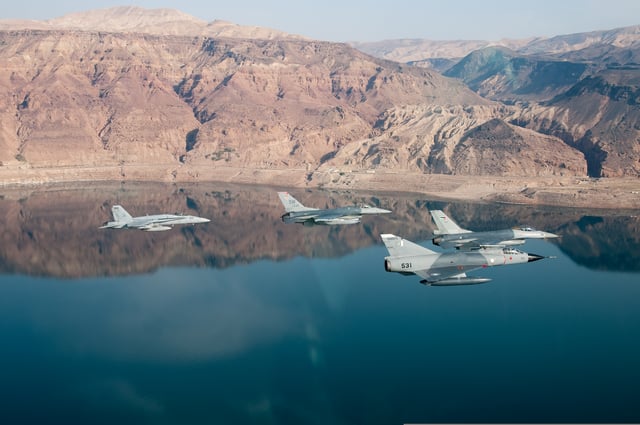
A PAF Mirage III of No. 7 Bandits Squadron alongside a US Navy F-18 and F-16s of the USAF and RJAF
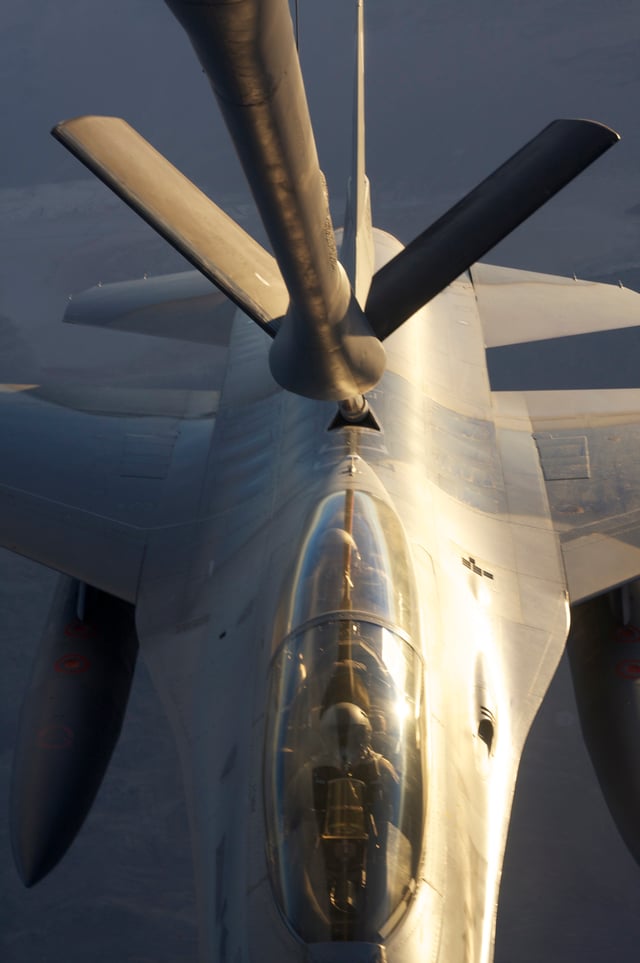
A PAF F-16 is refuelled in-flight by a USAF KC-135 tanker during Red Flag 2010.
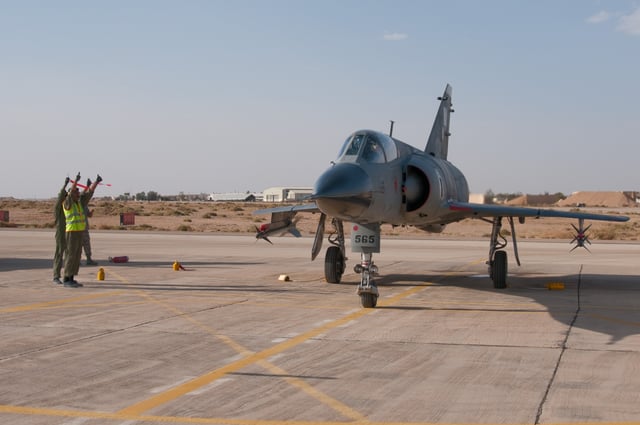
A PAF Mirage III competes in the Alert Scramble Competition during Falcon Air Meet 2010 in Jordan.
After around one year of planning, in 2005 the PAF launched the High Mark 2005 exercise which lasted for one month and also involved the Pakistan Army and Pakistan Navy. The scenario saw two opposing forces, Blueland and Foxland, engaging in simulated combat involving both offensive and defensive operations. It was stated that the exercise would have 3 stages and PAF aircraft would fly 8200 sorties. Involvement of army and navy units was aimed at providing more realistic operational scenarios. High Mark 2005 followed the Tempest-1 exercise which was focused purely on air power but differed in terms of duration, intensity and complexity of air operations.[160]
A contingent of six F-16A/B fighters was sent to Turkey's international Anatolian Eagle 2006 exercise. In 2008 the Turkish Air Force sent five F-16C/D fighters and 50 personnel of 191 Kobras Filo (191 Cobras Squadron) to Pakistan to take part in the joint Operation Indus Viper 2008 exercise at PAF Base Mushaf (Sargodha).[159]
In December 2009 the PAF sent six Chengdu F-7PG fighters, of No. 31 Wing based at PAF Base Samungli, to the United Arab Emirates to take part in the Air Tactics Leadership Course (ATLC), also known as Exercise Iron Falcon, at Al Dhafra Air Base.[166][167][168]
The PAF's High Mark 2010 exercise was launched on 15 March 2010, the first time a High Mark exercise had been conducted since 2005, after all PAF received their Air Tasking Orders (ATO). The country-wide exercise involved units based all over Pakistan, from Skardu to the Arabian Sea, at all Main Operating Bases and Forward Operating Bases. Joint operations involving the Pakistan Army and Pakistan Navy were also conducted, aiming to test and improve integration and co-operation between the three arms. Operations emphasised a near-realistic simulation of the war-time environment, exposure of PAF aircrews to contemporary concepts of air combat, new employment concepts and joint operations between air force, army and navy. New inductions such as the JF-17 Thunder fighter, Saab 2000 Erieye AEW&C and Il-78 Multi-Role Tanker Transports also took part.[169] On 6 April 2010 the end of the first phase of exercise High Mark 2010 was celebrated with a firepower demonstration at the PAF's firing range facility in the deserts of Thal. The 90-minute demo involved the new JF-17 Thunder fighter, Saab 2000 Erieye AEW&C and Il-78 MRTT aircraft. The H-2 SOW (Stand-Off Weapon) was also shown to the public for the first time, being launched from around 60 km away before hitting its target, and a mock counter-insurgency operation was performed by troops. The demo heralded the beginning of High Mark 2010's second phase where the PAF would practice joint operations with the Pakistan Army during the army's exercise Azm-e-Nau-3 (New Resolve 3).[170] During High Mark 2010 a Chengdu F-7 and Mirage 5 fighter (flown by Squadron Leader Nasir Mehmood and Wing Commander Atta ur Rehman respectively) practised landing, refuelling and take-off operations from a Pakistani motorway. It was reported that the PAF is in negotiations with the Ministry of Communications to set up all required facilities for Air Force operations on the motorways and highways of Pakistan.[171][172]
In July 2010 the PAF sent six F-16B fighters of No. 9 Griffins Squadron and 100 PAF personnel to Nellis Air Force Base in the U.S. to participate in the international Red Flag exercise for the first time. During the exercise the PAF pilots practised in-flight refuelling of their F-16s with the Boeing KC-135 Stratotanker.[173][174][175][176][177]
In October 2010 the PAF's No. 7 Bandits Squadron sent a team of its Dassault Mirage III ROSE fighters to Jordan to participate in the Falcon Air Meet 2010 exercise at Azraq Royal Jordanian Air Base.[178][179] January 2011 saw a PAF contingent of F-16A/B and Dassault Mirage fighters take part in the Al-Saqoor II exercise in Saudi Arabia with the Royal Saudi Air Force.[180][181][182]
In March 2011 a joint Sino-Pakistani exercise, Shaheen 1, was conducted involving a contingent of Chinese aircraft and personnel from the PLAAF.[183] Information on which aircraft were used by each side in the exercise was not released, but photos of Pakistani pilots inspecting what appeared to be Chinese Shenyang J-11B fighters were released on the internet. The exercise lasted for around 4 weeks and was the first time the PLAAF had deployed to and conducted "operational" aerial manoeuvres in Pakistan with the PAF.[184]
Involvement in Pakistani society
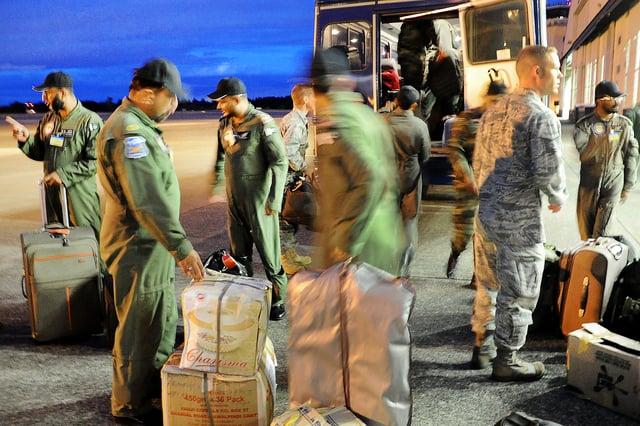
Pakistan Air Force airmen are participating in relief operations
The Pakistan Air Force has played an integral part in the civil society of Pakistan, almost since its inception.[185] In 1996, General Jehangir Karamat described Pakistan armed forces' relations with the society:
In my opinion, if we have to repeat of past events then we must understand that Military leaders can pressure only up to a point. Beyond that their own position starts getting undermined because the military is after all is a mirror image of the civil society from which it is drawn.— General Jehangir Karamat on civil society–military relations, [185]
In times of natural disaster, such as the great floods of 1992 or the October 2005 devastating earthquake, air force engineers, medical and logistics personnel, and the armed forces played a major role in bringing relief and supplies.[186]
The Pakistan Air Force has been involved in relief activities not only in Pakistan but also in many other countries of the world, such as the relief activities after Bangladesh was hit by floods.[186] The Air Force also dispatched relief to Indonesia, Bangladesh and Sri Lanka after they were hit by the 2004 Indian Ocean earthquake and the resulting tsunami. The Pakistan Army, Air Force, and Navy sent ships and helicopters to assist in the tsunami relief operation.[186]
In popular Pakistani culture
In Pakistani literature, the shaheen has a special association with the poetry of the country's national poet, Allama Muhammad Iqbal.[187] It also appears on the official seal of the Pakistan Air Force logo.
The Urdu drama serials on PAF have been written, produced, directed, and televised in the television. The highly acclaimed Urdu drama serials Shahpar ran on PTV and Sherdil were televised on ARY Digital.[188]
See also
Special Services Wing
Air Force Strategic Command
List of Pakistan Air Force Bases
List of Pakistan Air Force squadrons
List of Dassault Mirage III operators
List of Lockheed F-104 Starfighter operators
List of retired Pakistan Air Force aircraft
Pakistan Aeronautical Complex
Pakistan Naval Air Arm
PAF Hospitals
PAF Museum, Karachi
Pakistan Army Aviation Corps
Pakistan and weapons of mass destruction
Islamic Military Counter Terrorism Coalition






















